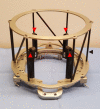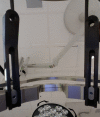Presurgical Rehearsals for Patients Considering "Awake" Deep Brain Stimulation
- PMID: 27532036
- PMCID: PMC4970521
- DOI: 10.3389/fsurg.2016.00044
Presurgical Rehearsals for Patients Considering "Awake" Deep Brain Stimulation
Abstract
Simulated surgical environments are rapidly gaining adoption in training students, residents, and members of specialized surgical teams. However, minimal attention has been given to the use of simulated surgical environments to educate patients on surgical processes, particularly procedures that require the active participation of the patient. "Awake" neurosurgery provides a unique situation in which patients openly participate in their operation. We describe a case report, in which a 62-year-old male was referred for "awake" deep brain stimulation implantation, in relation to medically refractory Parkinson's disease. The patient had significant concerns regarding anxiety and claustrophobia, and toleration of the "awake" procedure. Consequently, we designed a simulated OR environment and process, to recreate the physical experience of the procedure, with minimal cost or risk. This experience was crucial in determining the care plan, as after this experience, the patient opted for an "asleep" alternative. Thus, in certain settings, presurgical rehearsals may have a dramatic impact in the overall course of care.
Keywords: DBS; Parkinson’s disease; awake neurosurgery; patient experience; surgical simulation.
Figures






Similar articles
-
Cost analysis of awake versus asleep deep brain stimulation: a single academic health center experience.J Neurosurg. 2016 May;124(5):1517-23. doi: 10.3171/2015.5.JNS15433. Epub 2015 Nov 20. J Neurosurg. 2016. PMID: 26587660
-
Complication rates, lengths of stay, and readmission rates in "awake" and "asleep" deep brain simulation.J Neurosurg. 2017 Aug;127(2):360-369. doi: 10.3171/2016.6.JNS152946. Epub 2016 Sep 23. J Neurosurg. 2017. PMID: 27662532
-
Parkinson's disease patient preference and experience with various methods of DBS lead placement.Parkinsonism Relat Disord. 2017 Aug;41:25-30. doi: 10.1016/j.parkreldis.2017.04.010. Epub 2017 Apr 17. Parkinsonism Relat Disord. 2017. PMID: 28615151
-
Awake versus Asleep Deep Brain Stimulation Surgery: Technical Considerations and Critical Review of the Literature.Brain Sci. 2018 Jan 19;8(1):17. doi: 10.3390/brainsci8010017. Brain Sci. 2018. PMID: 29351243 Free PMC article. Review.
-
Congress of Neurological Surgeons Systematic Review and Evidence-Based Guideline on Subthalamic Nucleus and Globus Pallidus Internus Deep Brain Stimulation for the Treatment of Patients With Parkinson's Disease: Executive Summary.Neurosurgery. 2018 Jun 1;82(6):753-756. doi: 10.1093/neuros/nyy037. Neurosurgery. 2018. PMID: 29538685 Free PMC article.
Cited by
-
"Grass Is Always Greener on the Other Side" or Is It?! Comparison of Trend of Awake Craniotomy in Neuro-Oncology and Asleep Deep Brain Stimulation.Stereotact Funct Neurosurg. 2023;101(3):217-220. doi: 10.1159/000530527. Epub 2023 May 15. Stereotact Funct Neurosurg. 2023. PMID: 37231910 Free PMC article. No abstract available.
-
Posterior Fossa Stereotactic Biopsy with Leksell Vantage Frame-Case Series and Review of Literature.J Clin Med. 2025 Jan 18;14(2):609. doi: 10.3390/jcm14020609. J Clin Med. 2025. PMID: 39860615 Free PMC article. Review.
References
Publication types
LinkOut - more resources
Full Text Sources
Other Literature Sources

